LAW513 Assignment 1: Examining Corporate Veil, Attributes, and Law
VerifiedAdded on 2023/06/08
|8
|2084
|353
Essay
AI Summary
This essay comprehensively examines the concept of the corporate veil in business law, beginning with an explanation of the attributes a company gains upon incorporation, such as separate legal entity, perpetual existence, a common seal, limited liability, transfer of ownership, and separation of management and ownership. It then delves into the meaning of the corporate veil, referencing the landmark case of Salomon v. Salomon and Co. Ltd., and discusses how it separates the identity of a corporation from its managers and shareholders. The essay further identifies problems that arise for third parties due to the existence of the corporate veil, particularly concerning creditors and their ability to recover debts. Lastly, it outlines circumstances, both at common law and under statutes, where the corporate veil may be ignored or lifted, including instances of fraud, avoidance of legal obligations, tax evasion, or when the company is deemed an enemy of the state. The essay references several key legal cases to support its analysis, providing a thorough overview of the corporate veil doctrine and its implications.
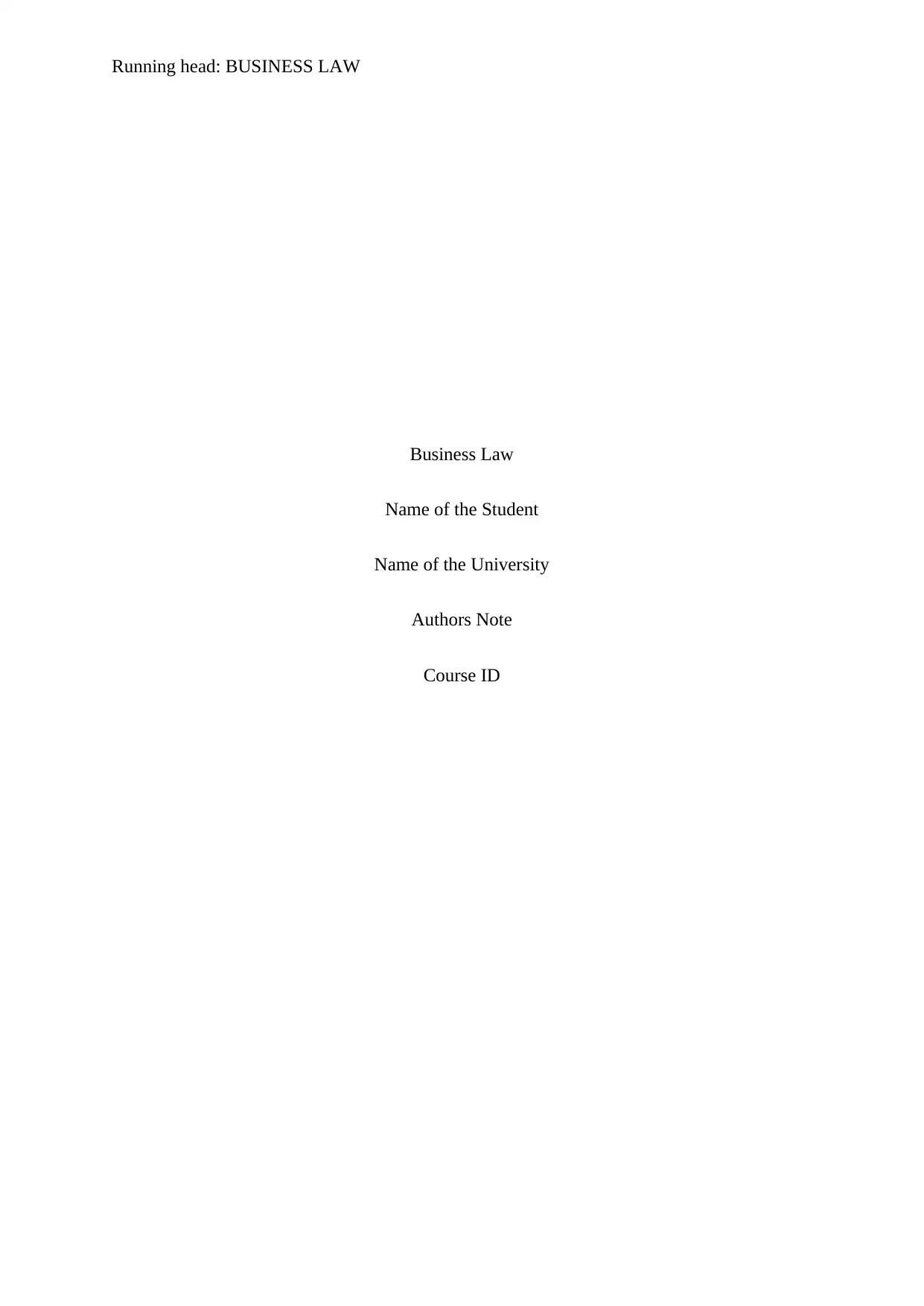
Running head: BUSINESS LAW
Business Law
Name of the Student
Name of the University
Authors Note
Course ID
Business Law
Name of the Student
Name of the University
Authors Note
Course ID
Paraphrase This Document
Need a fresh take? Get an instant paraphrase of this document with our AI Paraphraser
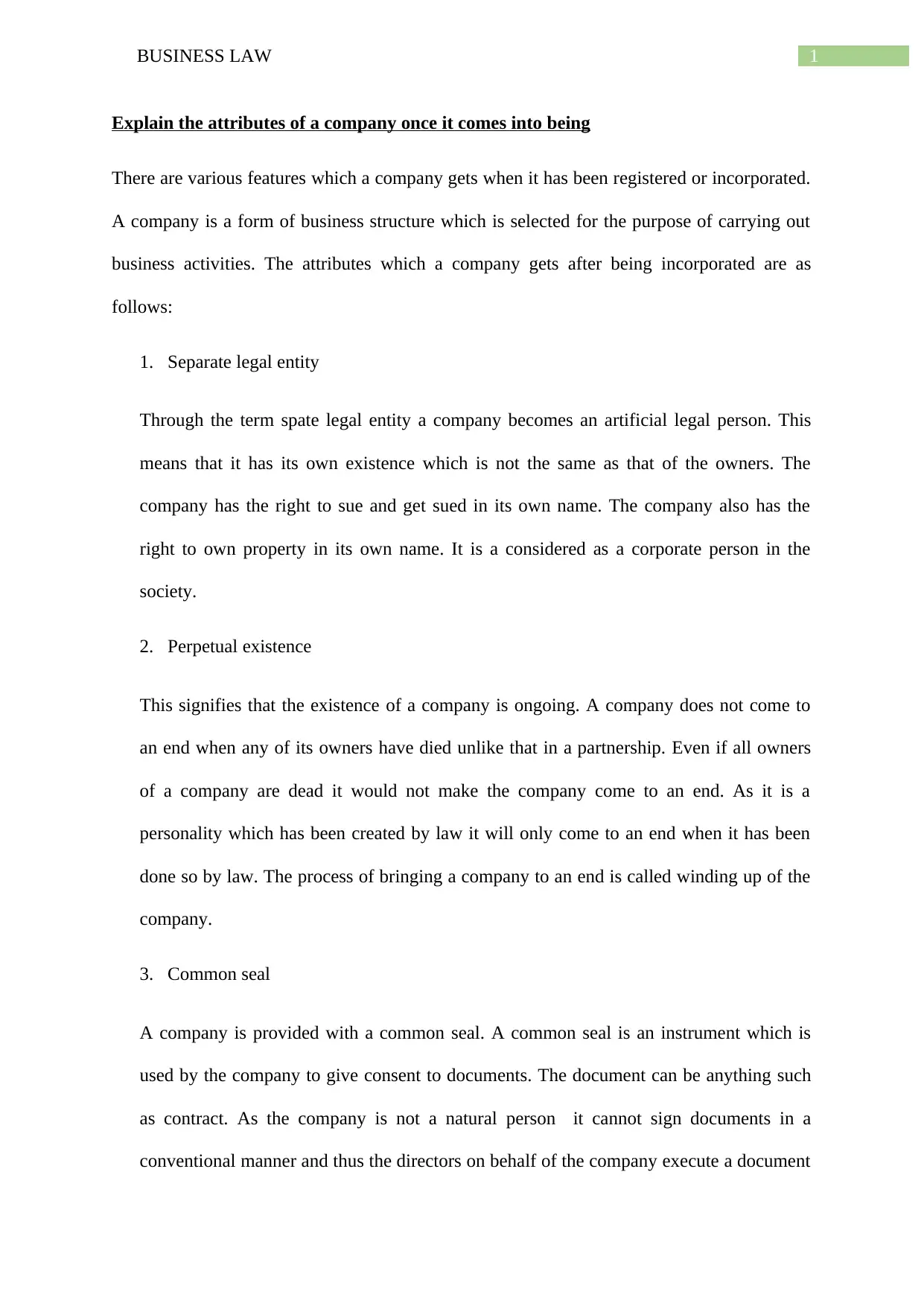
1BUSINESS LAW
Explain the attributes of a company once it comes into being
There are various features which a company gets when it has been registered or incorporated.
A company is a form of business structure which is selected for the purpose of carrying out
business activities. The attributes which a company gets after being incorporated are as
follows:
1. Separate legal entity
Through the term spate legal entity a company becomes an artificial legal person. This
means that it has its own existence which is not the same as that of the owners. The
company has the right to sue and get sued in its own name. The company also has the
right to own property in its own name. It is a considered as a corporate person in the
society.
2. Perpetual existence
This signifies that the existence of a company is ongoing. A company does not come to
an end when any of its owners have died unlike that in a partnership. Even if all owners
of a company are dead it would not make the company come to an end. As it is a
personality which has been created by law it will only come to an end when it has been
done so by law. The process of bringing a company to an end is called winding up of the
company.
3. Common seal
A company is provided with a common seal. A common seal is an instrument which is
used by the company to give consent to documents. The document can be anything such
as contract. As the company is not a natural person it cannot sign documents in a
conventional manner and thus the directors on behalf of the company execute a document
Explain the attributes of a company once it comes into being
There are various features which a company gets when it has been registered or incorporated.
A company is a form of business structure which is selected for the purpose of carrying out
business activities. The attributes which a company gets after being incorporated are as
follows:
1. Separate legal entity
Through the term spate legal entity a company becomes an artificial legal person. This
means that it has its own existence which is not the same as that of the owners. The
company has the right to sue and get sued in its own name. The company also has the
right to own property in its own name. It is a considered as a corporate person in the
society.
2. Perpetual existence
This signifies that the existence of a company is ongoing. A company does not come to
an end when any of its owners have died unlike that in a partnership. Even if all owners
of a company are dead it would not make the company come to an end. As it is a
personality which has been created by law it will only come to an end when it has been
done so by law. The process of bringing a company to an end is called winding up of the
company.
3. Common seal
A company is provided with a common seal. A common seal is an instrument which is
used by the company to give consent to documents. The document can be anything such
as contract. As the company is not a natural person it cannot sign documents in a
conventional manner and thus the directors on behalf of the company execute a document
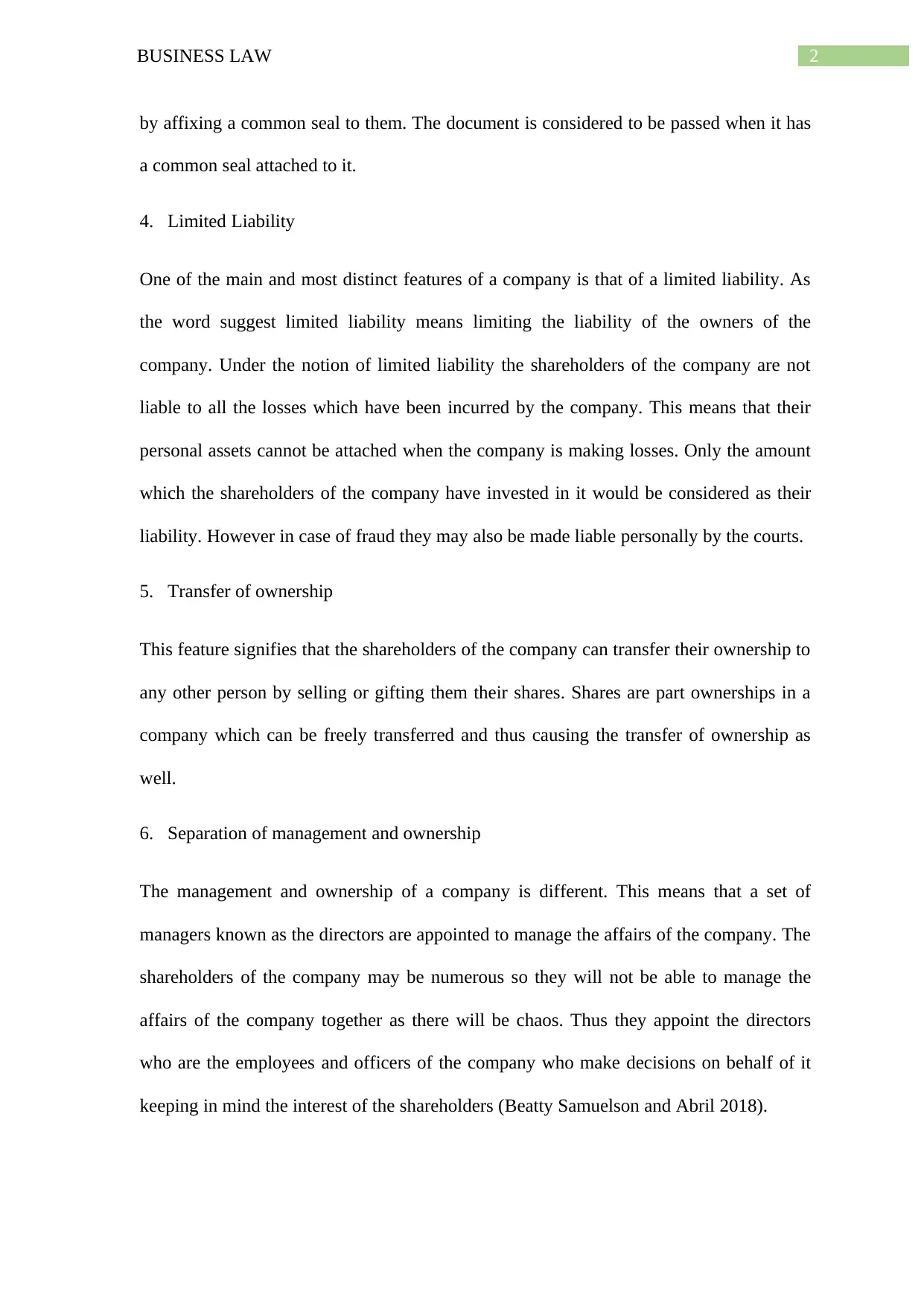
2BUSINESS LAW
by affixing a common seal to them. The document is considered to be passed when it has
a common seal attached to it.
4. Limited Liability
One of the main and most distinct features of a company is that of a limited liability. As
the word suggest limited liability means limiting the liability of the owners of the
company. Under the notion of limited liability the shareholders of the company are not
liable to all the losses which have been incurred by the company. This means that their
personal assets cannot be attached when the company is making losses. Only the amount
which the shareholders of the company have invested in it would be considered as their
liability. However in case of fraud they may also be made liable personally by the courts.
5. Transfer of ownership
This feature signifies that the shareholders of the company can transfer their ownership to
any other person by selling or gifting them their shares. Shares are part ownerships in a
company which can be freely transferred and thus causing the transfer of ownership as
well.
6. Separation of management and ownership
The management and ownership of a company is different. This means that a set of
managers known as the directors are appointed to manage the affairs of the company. The
shareholders of the company may be numerous so they will not be able to manage the
affairs of the company together as there will be chaos. Thus they appoint the directors
who are the employees and officers of the company who make decisions on behalf of it
keeping in mind the interest of the shareholders (Beatty Samuelson and Abril 2018).
by affixing a common seal to them. The document is considered to be passed when it has
a common seal attached to it.
4. Limited Liability
One of the main and most distinct features of a company is that of a limited liability. As
the word suggest limited liability means limiting the liability of the owners of the
company. Under the notion of limited liability the shareholders of the company are not
liable to all the losses which have been incurred by the company. This means that their
personal assets cannot be attached when the company is making losses. Only the amount
which the shareholders of the company have invested in it would be considered as their
liability. However in case of fraud they may also be made liable personally by the courts.
5. Transfer of ownership
This feature signifies that the shareholders of the company can transfer their ownership to
any other person by selling or gifting them their shares. Shares are part ownerships in a
company which can be freely transferred and thus causing the transfer of ownership as
well.
6. Separation of management and ownership
The management and ownership of a company is different. This means that a set of
managers known as the directors are appointed to manage the affairs of the company. The
shareholders of the company may be numerous so they will not be able to manage the
affairs of the company together as there will be chaos. Thus they appoint the directors
who are the employees and officers of the company who make decisions on behalf of it
keeping in mind the interest of the shareholders (Beatty Samuelson and Abril 2018).
⊘ This is a preview!⊘
Do you want full access?
Subscribe today to unlock all pages.

Trusted by 1+ million students worldwide
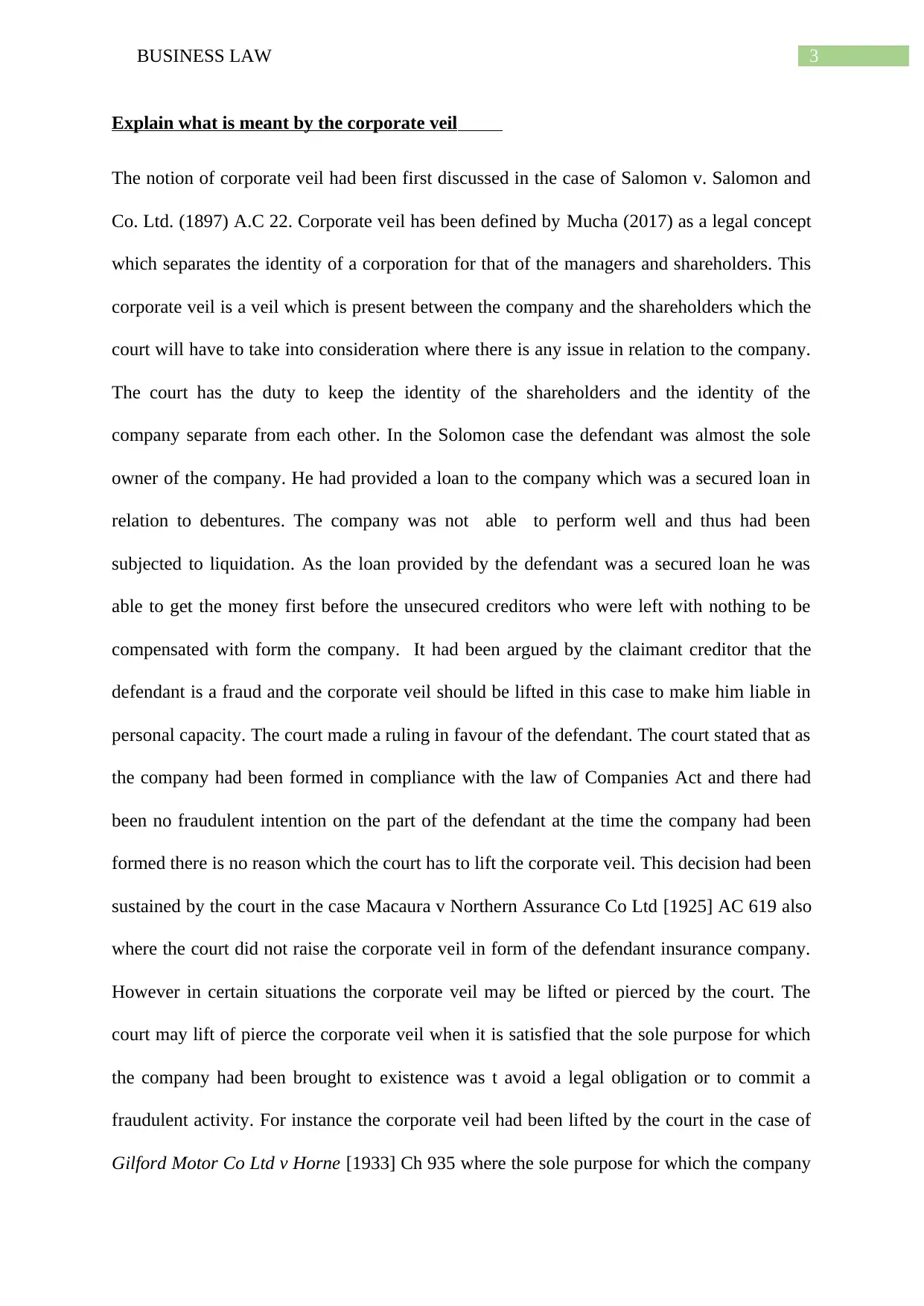
3BUSINESS LAW
Explain what is meant by the corporate veil
The notion of corporate veil had been first discussed in the case of Salomon v. Salomon and
Co. Ltd. (1897) A.C 22. Corporate veil has been defined by Mucha (2017) as a legal concept
which separates the identity of a corporation for that of the managers and shareholders. This
corporate veil is a veil which is present between the company and the shareholders which the
court will have to take into consideration where there is any issue in relation to the company.
The court has the duty to keep the identity of the shareholders and the identity of the
company separate from each other. In the Solomon case the defendant was almost the sole
owner of the company. He had provided a loan to the company which was a secured loan in
relation to debentures. The company was not able to perform well and thus had been
subjected to liquidation. As the loan provided by the defendant was a secured loan he was
able to get the money first before the unsecured creditors who were left with nothing to be
compensated with form the company. It had been argued by the claimant creditor that the
defendant is a fraud and the corporate veil should be lifted in this case to make him liable in
personal capacity. The court made a ruling in favour of the defendant. The court stated that as
the company had been formed in compliance with the law of Companies Act and there had
been no fraudulent intention on the part of the defendant at the time the company had been
formed there is no reason which the court has to lift the corporate veil. This decision had been
sustained by the court in the case Macaura v Northern Assurance Co Ltd [1925] AC 619 also
where the court did not raise the corporate veil in form of the defendant insurance company.
However in certain situations the corporate veil may be lifted or pierced by the court. The
court may lift of pierce the corporate veil when it is satisfied that the sole purpose for which
the company had been brought to existence was t avoid a legal obligation or to commit a
fraudulent activity. For instance the corporate veil had been lifted by the court in the case of
Gilford Motor Co Ltd v Horne [1933] Ch 935 where the sole purpose for which the company
Explain what is meant by the corporate veil
The notion of corporate veil had been first discussed in the case of Salomon v. Salomon and
Co. Ltd. (1897) A.C 22. Corporate veil has been defined by Mucha (2017) as a legal concept
which separates the identity of a corporation for that of the managers and shareholders. This
corporate veil is a veil which is present between the company and the shareholders which the
court will have to take into consideration where there is any issue in relation to the company.
The court has the duty to keep the identity of the shareholders and the identity of the
company separate from each other. In the Solomon case the defendant was almost the sole
owner of the company. He had provided a loan to the company which was a secured loan in
relation to debentures. The company was not able to perform well and thus had been
subjected to liquidation. As the loan provided by the defendant was a secured loan he was
able to get the money first before the unsecured creditors who were left with nothing to be
compensated with form the company. It had been argued by the claimant creditor that the
defendant is a fraud and the corporate veil should be lifted in this case to make him liable in
personal capacity. The court made a ruling in favour of the defendant. The court stated that as
the company had been formed in compliance with the law of Companies Act and there had
been no fraudulent intention on the part of the defendant at the time the company had been
formed there is no reason which the court has to lift the corporate veil. This decision had been
sustained by the court in the case Macaura v Northern Assurance Co Ltd [1925] AC 619 also
where the court did not raise the corporate veil in form of the defendant insurance company.
However in certain situations the corporate veil may be lifted or pierced by the court. The
court may lift of pierce the corporate veil when it is satisfied that the sole purpose for which
the company had been brought to existence was t avoid a legal obligation or to commit a
fraudulent activity. For instance the corporate veil had been lifted by the court in the case of
Gilford Motor Co Ltd v Horne [1933] Ch 935 where the sole purpose for which the company
Paraphrase This Document
Need a fresh take? Get an instant paraphrase of this document with our AI Paraphraser
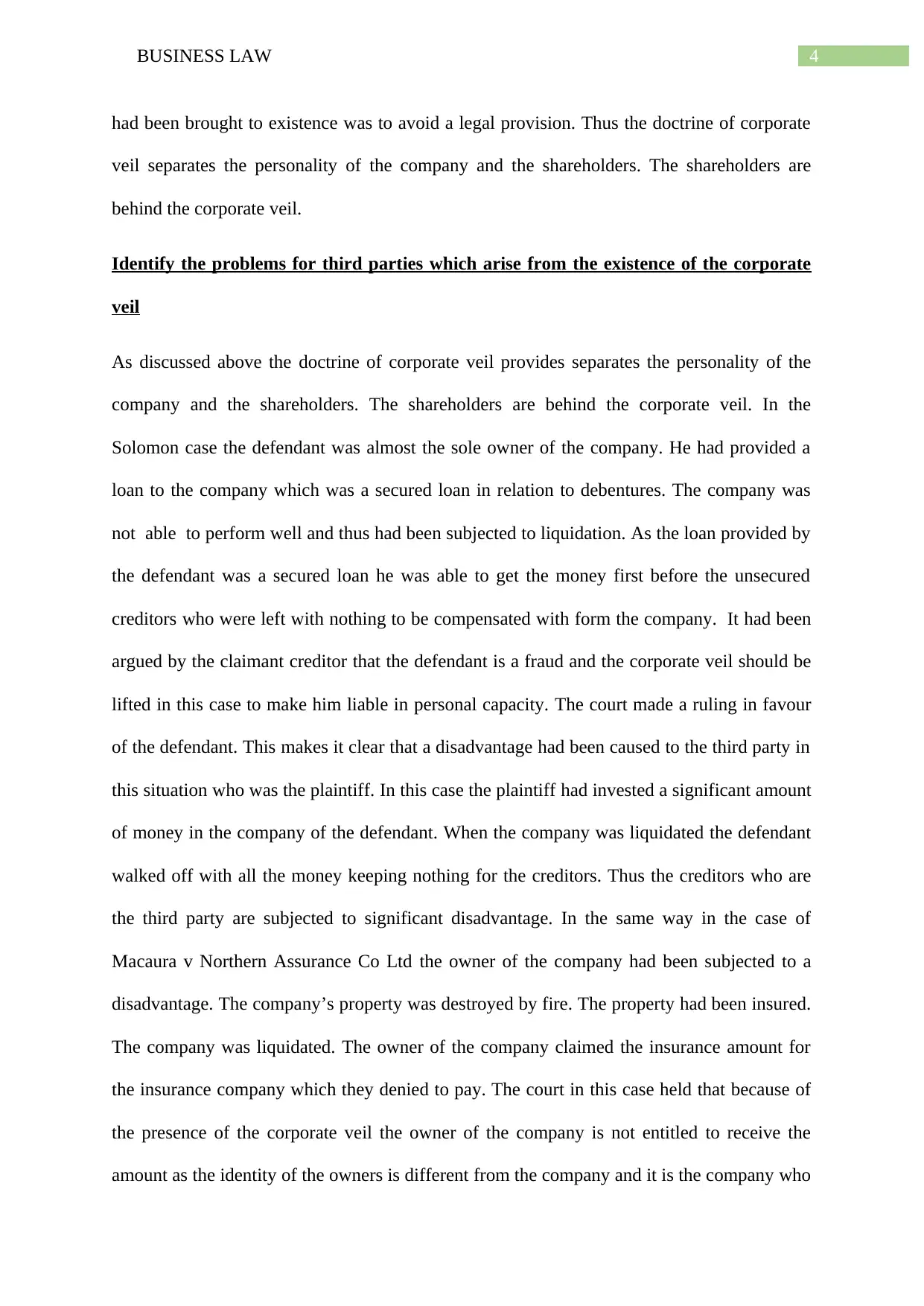
4BUSINESS LAW
had been brought to existence was to avoid a legal provision. Thus the doctrine of corporate
veil separates the personality of the company and the shareholders. The shareholders are
behind the corporate veil.
Identify the problems for third parties which arise from the existence of the corporate
veil
As discussed above the doctrine of corporate veil provides separates the personality of the
company and the shareholders. The shareholders are behind the corporate veil. In the
Solomon case the defendant was almost the sole owner of the company. He had provided a
loan to the company which was a secured loan in relation to debentures. The company was
not able to perform well and thus had been subjected to liquidation. As the loan provided by
the defendant was a secured loan he was able to get the money first before the unsecured
creditors who were left with nothing to be compensated with form the company. It had been
argued by the claimant creditor that the defendant is a fraud and the corporate veil should be
lifted in this case to make him liable in personal capacity. The court made a ruling in favour
of the defendant. This makes it clear that a disadvantage had been caused to the third party in
this situation who was the plaintiff. In this case the plaintiff had invested a significant amount
of money in the company of the defendant. When the company was liquidated the defendant
walked off with all the money keeping nothing for the creditors. Thus the creditors who are
the third party are subjected to significant disadvantage. In the same way in the case of
Macaura v Northern Assurance Co Ltd the owner of the company had been subjected to a
disadvantage. The company’s property was destroyed by fire. The property had been insured.
The company was liquidated. The owner of the company claimed the insurance amount for
the insurance company which they denied to pay. The court in this case held that because of
the presence of the corporate veil the owner of the company is not entitled to receive the
amount as the identity of the owners is different from the company and it is the company who
had been brought to existence was to avoid a legal provision. Thus the doctrine of corporate
veil separates the personality of the company and the shareholders. The shareholders are
behind the corporate veil.
Identify the problems for third parties which arise from the existence of the corporate
veil
As discussed above the doctrine of corporate veil provides separates the personality of the
company and the shareholders. The shareholders are behind the corporate veil. In the
Solomon case the defendant was almost the sole owner of the company. He had provided a
loan to the company which was a secured loan in relation to debentures. The company was
not able to perform well and thus had been subjected to liquidation. As the loan provided by
the defendant was a secured loan he was able to get the money first before the unsecured
creditors who were left with nothing to be compensated with form the company. It had been
argued by the claimant creditor that the defendant is a fraud and the corporate veil should be
lifted in this case to make him liable in personal capacity. The court made a ruling in favour
of the defendant. This makes it clear that a disadvantage had been caused to the third party in
this situation who was the plaintiff. In this case the plaintiff had invested a significant amount
of money in the company of the defendant. When the company was liquidated the defendant
walked off with all the money keeping nothing for the creditors. Thus the creditors who are
the third party are subjected to significant disadvantage. In the same way in the case of
Macaura v Northern Assurance Co Ltd the owner of the company had been subjected to a
disadvantage. The company’s property was destroyed by fire. The property had been insured.
The company was liquidated. The owner of the company claimed the insurance amount for
the insurance company which they denied to pay. The court in this case held that because of
the presence of the corporate veil the owner of the company is not entitled to receive the
amount as the identity of the owners is different from the company and it is the company who
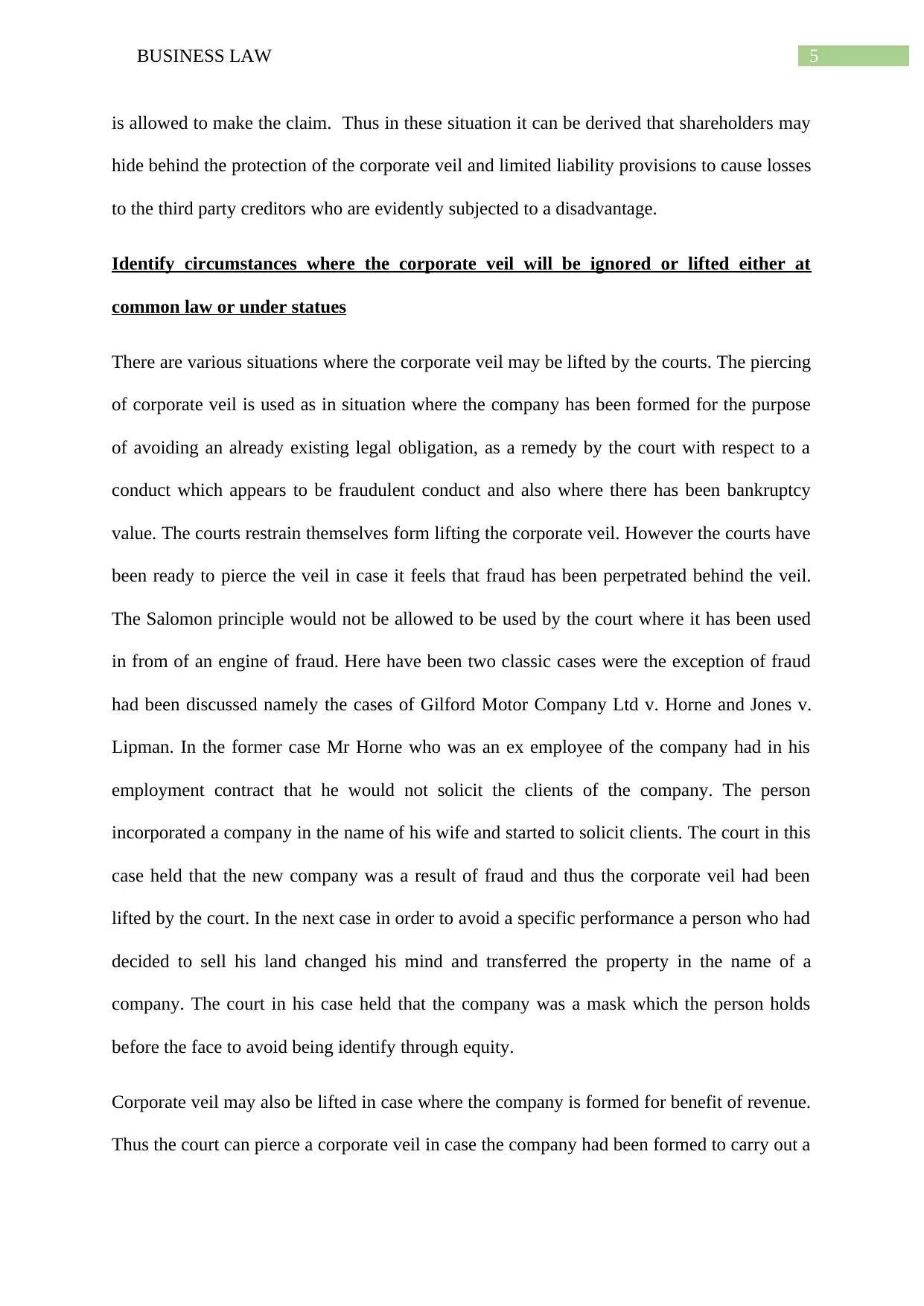
5BUSINESS LAW
is allowed to make the claim. Thus in these situation it can be derived that shareholders may
hide behind the protection of the corporate veil and limited liability provisions to cause losses
to the third party creditors who are evidently subjected to a disadvantage.
Identify circumstances where the corporate veil will be ignored or lifted either at
common law or under statues
There are various situations where the corporate veil may be lifted by the courts. The piercing
of corporate veil is used as in situation where the company has been formed for the purpose
of avoiding an already existing legal obligation, as a remedy by the court with respect to a
conduct which appears to be fraudulent conduct and also where there has been bankruptcy
value. The courts restrain themselves form lifting the corporate veil. However the courts have
been ready to pierce the veil in case it feels that fraud has been perpetrated behind the veil.
The Salomon principle would not be allowed to be used by the court where it has been used
in from of an engine of fraud. Here have been two classic cases were the exception of fraud
had been discussed namely the cases of Gilford Motor Company Ltd v. Horne and Jones v.
Lipman. In the former case Mr Horne who was an ex employee of the company had in his
employment contract that he would not solicit the clients of the company. The person
incorporated a company in the name of his wife and started to solicit clients. The court in this
case held that the new company was a result of fraud and thus the corporate veil had been
lifted by the court. In the next case in order to avoid a specific performance a person who had
decided to sell his land changed his mind and transferred the property in the name of a
company. The court in his case held that the company was a mask which the person holds
before the face to avoid being identify through equity.
Corporate veil may also be lifted in case where the company is formed for benefit of revenue.
Thus the court can pierce a corporate veil in case the company had been formed to carry out a
is allowed to make the claim. Thus in these situation it can be derived that shareholders may
hide behind the protection of the corporate veil and limited liability provisions to cause losses
to the third party creditors who are evidently subjected to a disadvantage.
Identify circumstances where the corporate veil will be ignored or lifted either at
common law or under statues
There are various situations where the corporate veil may be lifted by the courts. The piercing
of corporate veil is used as in situation where the company has been formed for the purpose
of avoiding an already existing legal obligation, as a remedy by the court with respect to a
conduct which appears to be fraudulent conduct and also where there has been bankruptcy
value. The courts restrain themselves form lifting the corporate veil. However the courts have
been ready to pierce the veil in case it feels that fraud has been perpetrated behind the veil.
The Salomon principle would not be allowed to be used by the court where it has been used
in from of an engine of fraud. Here have been two classic cases were the exception of fraud
had been discussed namely the cases of Gilford Motor Company Ltd v. Horne and Jones v.
Lipman. In the former case Mr Horne who was an ex employee of the company had in his
employment contract that he would not solicit the clients of the company. The person
incorporated a company in the name of his wife and started to solicit clients. The court in this
case held that the new company was a result of fraud and thus the corporate veil had been
lifted by the court. In the next case in order to avoid a specific performance a person who had
decided to sell his land changed his mind and transferred the property in the name of a
company. The court in his case held that the company was a mask which the person holds
before the face to avoid being identify through equity.
Corporate veil may also be lifted in case where the company is formed for benefit of revenue.
Thus the court can pierce a corporate veil in case the company had been formed to carry out a
⊘ This is a preview!⊘
Do you want full access?
Subscribe today to unlock all pages.

Trusted by 1+ million students worldwide
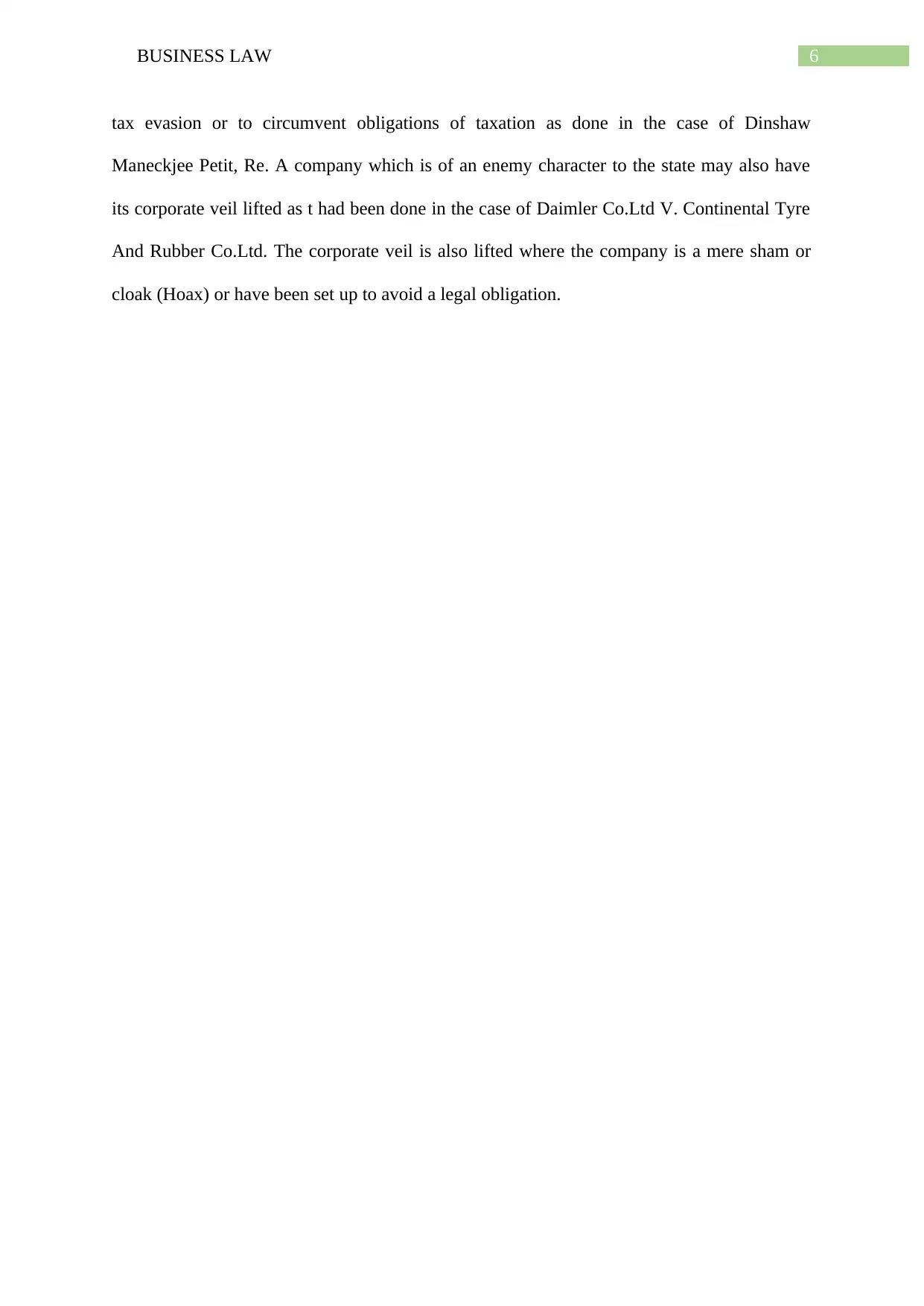
6BUSINESS LAW
tax evasion or to circumvent obligations of taxation as done in the case of Dinshaw
Maneckjee Petit, Re. A company which is of an enemy character to the state may also have
its corporate veil lifted as t had been done in the case of Daimler Co.Ltd V. Continental Tyre
And Rubber Co.Ltd. The corporate veil is also lifted where the company is a mere sham or
cloak (Hoax) or have been set up to avoid a legal obligation.
tax evasion or to circumvent obligations of taxation as done in the case of Dinshaw
Maneckjee Petit, Re. A company which is of an enemy character to the state may also have
its corporate veil lifted as t had been done in the case of Daimler Co.Ltd V. Continental Tyre
And Rubber Co.Ltd. The corporate veil is also lifted where the company is a mere sham or
cloak (Hoax) or have been set up to avoid a legal obligation.
Paraphrase This Document
Need a fresh take? Get an instant paraphrase of this document with our AI Paraphraser
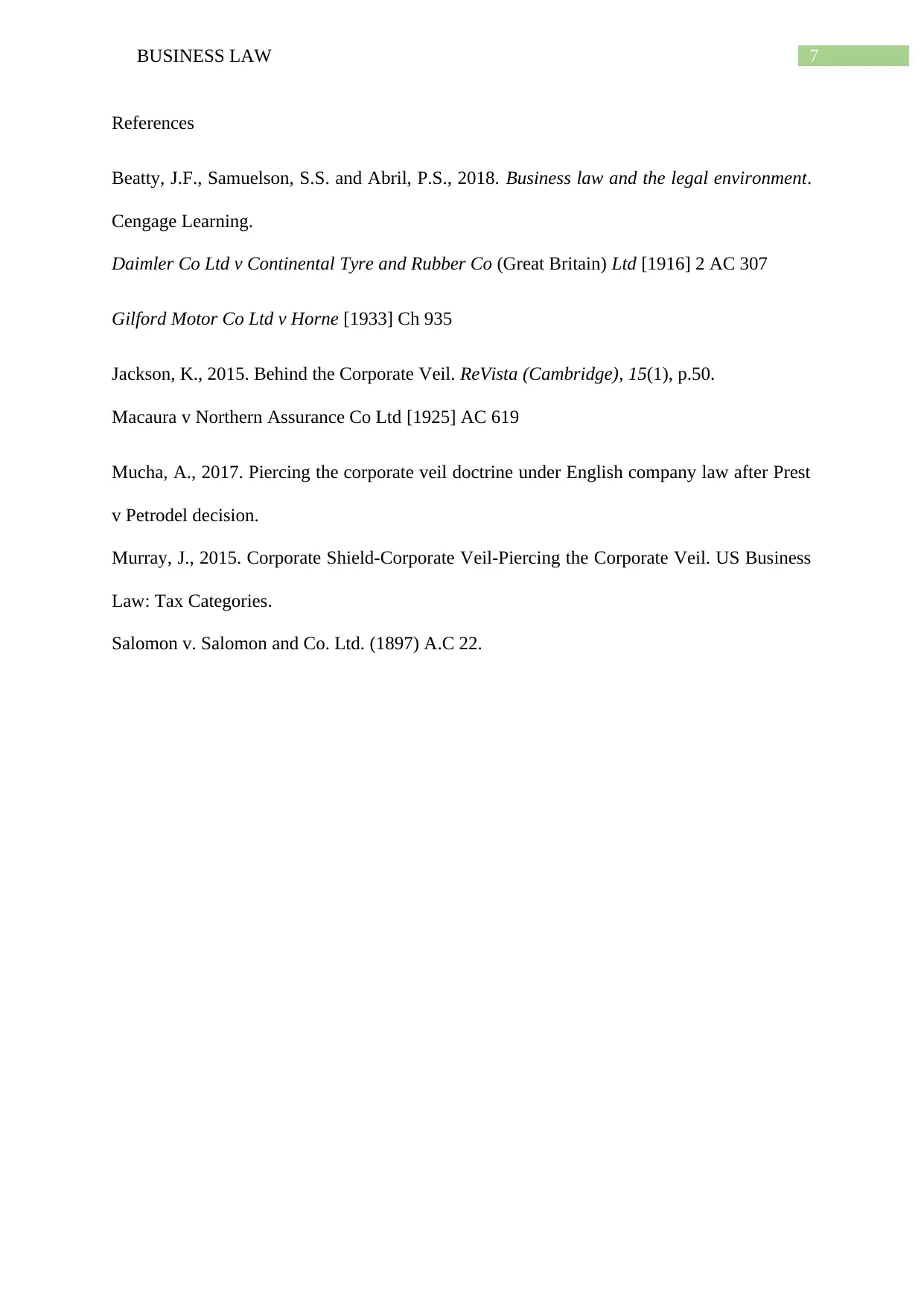
7BUSINESS LAW
References
Beatty, J.F., Samuelson, S.S. and Abril, P.S., 2018. Business law and the legal environment.
Cengage Learning.
Daimler Co Ltd v Continental Tyre and Rubber Co (Great Britain) Ltd [1916] 2 AC 307
Gilford Motor Co Ltd v Horne [1933] Ch 935
Jackson, K., 2015. Behind the Corporate Veil. ReVista (Cambridge), 15(1), p.50.
Macaura v Northern Assurance Co Ltd [1925] AC 619
Mucha, A., 2017. Piercing the corporate veil doctrine under English company law after Prest
v Petrodel decision.
Murray, J., 2015. Corporate Shield-Corporate Veil-Piercing the Corporate Veil. US Business
Law: Tax Categories.
Salomon v. Salomon and Co. Ltd. (1897) A.C 22.
References
Beatty, J.F., Samuelson, S.S. and Abril, P.S., 2018. Business law and the legal environment.
Cengage Learning.
Daimler Co Ltd v Continental Tyre and Rubber Co (Great Britain) Ltd [1916] 2 AC 307
Gilford Motor Co Ltd v Horne [1933] Ch 935
Jackson, K., 2015. Behind the Corporate Veil. ReVista (Cambridge), 15(1), p.50.
Macaura v Northern Assurance Co Ltd [1925] AC 619
Mucha, A., 2017. Piercing the corporate veil doctrine under English company law after Prest
v Petrodel decision.
Murray, J., 2015. Corporate Shield-Corporate Veil-Piercing the Corporate Veil. US Business
Law: Tax Categories.
Salomon v. Salomon and Co. Ltd. (1897) A.C 22.
1 out of 8
Related Documents
Your All-in-One AI-Powered Toolkit for Academic Success.
+13062052269
info@desklib.com
Available 24*7 on WhatsApp / Email
![[object Object]](/_next/static/media/star-bottom.7253800d.svg)
Unlock your academic potential
Copyright © 2020–2025 A2Z Services. All Rights Reserved. Developed and managed by ZUCOL.





